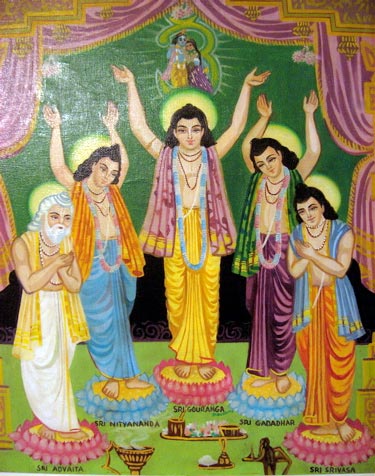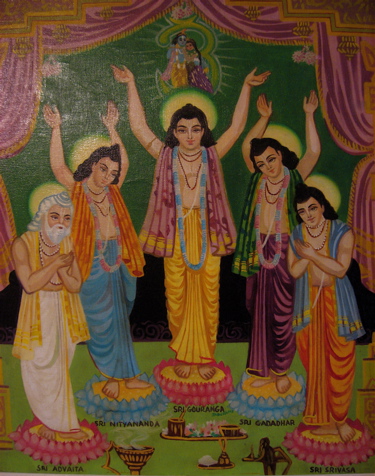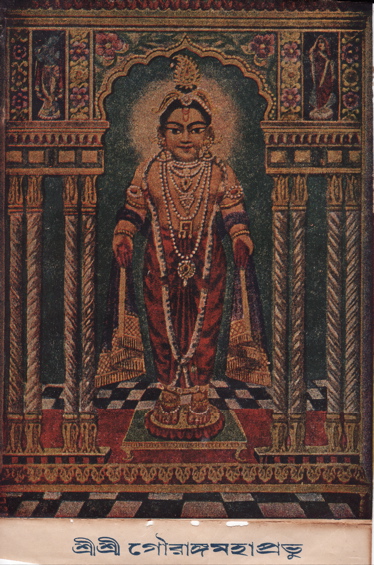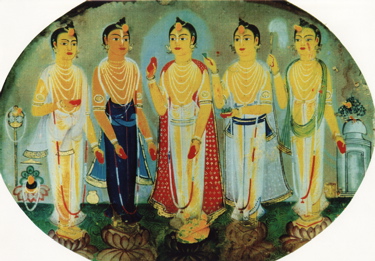Gaura Pūrṇimā 523
By Ravindra Svarupa Dasa | Mar 14, 2009

Five hundred and twenty three years ago, on a full moon night in the month of Govinda, ÅšrÄ« Caitanya MahÄprabhu appeared in the world, the avatÄra descended to deliver Kṛṣṇa prema to the extremely fallen people of this Kali-yuga.
Caitanya is Kṛṣṇa himself. In order to most completely offer his divine mercy, he does not come as the Lord. Covering his Godhood, he appears in the form of his own devotee (bhakta-rupa). The mercy of the Lord has ever been most fully delivered through his devotees. Not to be outdone, the Lord himself takes on the emotions and actions of his own devotee. He is thus both the supreme master and the supreme servant.
When he descends as Caitanya, he brings with him his divine expansions and energies, the closest of whom also act with him as devotees. The Lord and his four immediate associates constitute a set called the Pañca-tattva.
This is a photograph of the first Pañca-tattva painting made in the West. When PrabhupÄda came from India in 1965, he brought with him one of those small, mass-produced, cheap devotional prints of Pañca-tattva. Keeping it on a low table, he offered Ärati to it every day. Wanting a big Pañca-tattva image for the altar of the temple at 26 2nd Ave., in the fall of 1966 PrabhupÄda directed JadurÄṇī dÄsÄ«, who was then just learning to be an artist, to execute a larger, oil-on-canvas, representation based on his Indian print.
(She copied too exactly. After she’d finished, she asked PrabhupÄda what was the devanÄgarÄ« “Oá¹” sign, with RÄdhÄ and Kṛṣṇa wrapped inside, that hung over Lord Caitanya’s head. “The artist’s imagination,” PrabhupÄda replied.)
I first set eyes on this large Pañca-tattva in 1970, not in New York but in Philadelphia, when I paid my initial visit to a temple. ISKCON’s first center in my city humbly occupied, in a run-down University City neighborhood, a narrow row-house of blackend brick in a state of criminal disrepair—your standard student rental. There, the Pañca-tattva commanded the center of an altar set up in the bay of the front window.
Apparently by that time the devotees up in Manhattan had acquired a new, more skillfully executed painting of Pañca-tattva painting. The old one was passed down to Philadelphia.
This painting was my first deity. After I moved into the temple in 1971 (then relocated to the Germantown section), the Pañca-tattva became the recipient of my daily worship and meditation. The next year, when I was the temple president and large JagannÄtha deities came to occupy the altar, the Pañca-tattva painting remained in the temple room.
It kept its place of honor, even as we twice changed locations. In 1978, I was no longer the temple president. I served with the Bhaktivedanta Institute and lived outside. One day, a bright, brand-new Pañca-tattva painting appeared on the temple room wall. Soon afterward, my wife Saudamani dÄsÄ« happened to come upon the old Pañca-tattva painting down in the basement, propped on its side against the wall, amid a miscellany of castaway items.
A pang pierced her heart. She asked around: it was going to be discarded. I called the president. He told me they had at last gotten a far better picture. They didn’t need the old, embarrassingly amateurish, painting with its stiff figures. They just weren’t sure of the right way to dispose of a sacred object.
“Can I have it?”
“Sure. Take it. We don’t know what to do with it.”
All these years we’ve kept the old painting. Gradually, its status, having sunk far down, has climbed way back up. People are amazed that I have it. “That’s the very first Pañca-tattva painting in ISKCON.”
So it is. Now freshly cleaned, restored, and neatly framed, Saudamani and I continue to care for it. The Pañca-tattva, those five entirely numinous figures, give me daily association, and I regret only that the degree of my gratitude falls so far short of their mercy. Looking up at them as I type, I am thankful for the opportunity they are giving me to express my appreciation in public on this auspicious evening.
Two more pictures on my wall:
NavadvÄ«pa GaurÄá¹…ga
A print purchased from a Navadvīpa street stall.
Pañca-tattva
Photograph of a fresco in a temple somewhere in the Nadia district.
(The tulasÄ« leaf, affixed to Lord Caitanya’s feet with sandalwood paste, gives an indication of its actual size.)
The happiness of the Pañca-tattva
Here is a description from Caitanya-caritÄmá¹›ta of the essential activity of the Pañca-tattva, who have now so kindly appeared all over the world:
The characteristics of Kṛṣṇa are understood to be a storehouse of transcendental love. Although that storehouse of love certainly came with Kṛṣṇa when He was present, it was sealed. But when ÅšrÄ« Caitanya MahÄprabhu came with His associates of the Pañca-tattva, they broke the seal and plundered the storehouse to taste transcendental love of Kṛṣṇa. The more they tasted it, the more their thirst for it grew. ÅšrÄ« Pañca-tattva themselves danced again and again and thus made it easier to drink nectarean love of Godhead. They danced, cried, laughed and chanted like madmen, and in this way they distributed love of Godhead. In distributing love of Godhead, Caitanya MahÄprabhu and His associates did not consider who was a fit candidate and who was not, nor where such distribution should or should not take place. They made no conditions. Wherever they got the opportunity, the members of the Pañca-tattva distributed love of Godhead. Although the members of the Pañca-tattva plundered the storehouse of love of Godhead and ate and distributed its contents, there was no scarcity, for this wonderful storehouse is so complete that as the love is distributed, the supply increases hundreds of times. The flood of love of Godhead swelled in all directions, and thus young men, old men, women and children were all immersed in that inundation. The Kṛṣṇa consciousness movement will inundate the entire world and drown everyone, whether one be a gentleman, a rogue or even lame, invalid or blind. When the five members of the Pañca-tattva saw the entire world drowned in love of Godhead and the seed of material enjoyment in the living entities completely destroyed, they all became exceedingly happy. When the five members of the Pañca-tattva saw the entire world drowned in love of Godhead and the seed of material enjoyment in the living entities completely destroyed, they all became exceedingly happy.
—ÅšrÄ« Caitanya-caritÄmá¹›ta, Ä€dÄ«-lÄ«lÄ 7. 20-27


















